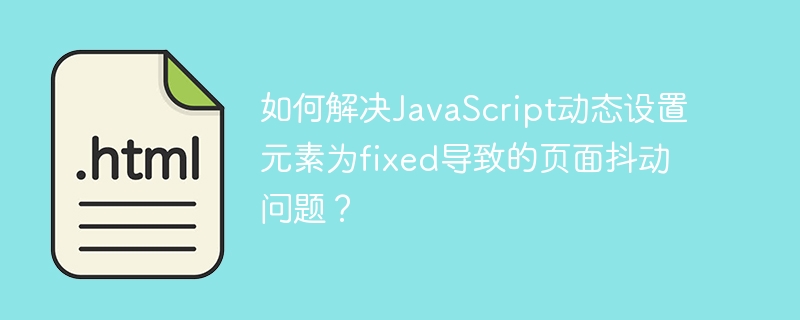 Web Front-end
Web Front-end
 HTML Tutorial
HTML Tutorial
 How to solve the problem of page jitter caused by dynamically setting elements to fixed in JavaScript?
How to solve the problem of page jitter caused by dynamically setting elements to fixed in JavaScript?
How to solve the problem of page jitter caused by dynamically setting elements to fixed in JavaScript?

JS dynamically set element to fixed page jitter and solution
When dynamically positioning elements as fixed using JavaScript, you often encounter problems with page jitter, especially when listening to scroll events and adjusting element positioning according to scroll position. This article will analyze the root causes of the problem and provide effective solutions.
The following code snippet shows common problem code that causes jitter:
window.addEventListener('scroll', this.handleTabFix);
handleTabFix () {
let timeOut = null;
clearTimeout(timeOut);
timeOut = setTimeout(() => {
const scrollTop = window.pageYOffset || document.documentElement.scrollTop || document.body.scrollTop;
const offsetTop = document.querySelector('#testNavBar')?.offsetTop 60;
this.isFixTab = scrollTop > offsetTop;
// When this.isFixTab is true, set the element to fixed
}, 1000);
} In the code, window.addEventListener listens for scrolling events, and handleTabFix function decides whether to set the element to fixed based on the scroll position. However, frequent fixed state switching can cause page height to change, causing jitter.
To address this problem, we propose two effective solutions:
Use
position: sticky: CSS'sposition: stickyattribute allows elements to remain in the view during scrolling without affecting the page layout, effectively avoiding jitter caused by height changes.Set a container with fixed height for an element: Add a container with fixed height to the element before setting it to
fixed. When the element becomesfixed, the container still occupies the original space, keeping the page height unchanged, thereby eliminating jitter.
Through the above methods, you can effectively solve the problem of page jitter caused by dynamically setting elements to fixed in JavaScript, ensuring a smooth scrolling experience for the page.
The above is the detailed content of How to solve the problem of page jitter caused by dynamically setting elements to fixed in JavaScript?. For more information, please follow other related articles on the PHP Chinese website!

Hot AI Tools

Undresser.AI Undress
AI-powered app for creating realistic nude photos

AI Clothes Remover
Online AI tool for removing clothes from photos.

Undress AI Tool
Undress images for free

Clothoff.io
AI clothes remover

Video Face Swap
Swap faces in any video effortlessly with our completely free AI face swap tool!

Hot Article

Hot Tools

Notepad++7.3.1
Easy-to-use and free code editor

SublimeText3 Chinese version
Chinese version, very easy to use

Zend Studio 13.0.1
Powerful PHP integrated development environment

Dreamweaver CS6
Visual web development tools

SublimeText3 Mac version
God-level code editing software (SublimeText3)

Hot Topics
 1657
1657
 14
14
 1415
1415
 52
52
 1309
1309
 25
25
 1257
1257
 29
29
 1229
1229
 24
24
 How to use bootstrap in vue
Apr 07, 2025 pm 11:33 PM
How to use bootstrap in vue
Apr 07, 2025 pm 11:33 PM
Using Bootstrap in Vue.js is divided into five steps: Install Bootstrap. Import Bootstrap in main.js. Use the Bootstrap component directly in the template. Optional: Custom style. Optional: Use plug-ins.
 Understanding HTML, CSS, and JavaScript: A Beginner's Guide
Apr 12, 2025 am 12:02 AM
Understanding HTML, CSS, and JavaScript: A Beginner's Guide
Apr 12, 2025 am 12:02 AM
WebdevelopmentreliesonHTML,CSS,andJavaScript:1)HTMLstructurescontent,2)CSSstylesit,and3)JavaScriptaddsinteractivity,formingthebasisofmodernwebexperiences.
 The Roles of HTML, CSS, and JavaScript: Core Responsibilities
Apr 08, 2025 pm 07:05 PM
The Roles of HTML, CSS, and JavaScript: Core Responsibilities
Apr 08, 2025 pm 07:05 PM
HTML defines the web structure, CSS is responsible for style and layout, and JavaScript gives dynamic interaction. The three perform their duties in web development and jointly build a colorful website.
 How to write split lines on bootstrap
Apr 07, 2025 pm 03:12 PM
How to write split lines on bootstrap
Apr 07, 2025 pm 03:12 PM
There are two ways to create a Bootstrap split line: using the tag, which creates a horizontal split line. Use the CSS border property to create custom style split lines.
 How to insert pictures on bootstrap
Apr 07, 2025 pm 03:30 PM
How to insert pictures on bootstrap
Apr 07, 2025 pm 03:30 PM
There are several ways to insert images in Bootstrap: insert images directly, using the HTML img tag. With the Bootstrap image component, you can provide responsive images and more styles. Set the image size, use the img-fluid class to make the image adaptable. Set the border, using the img-bordered class. Set the rounded corners and use the img-rounded class. Set the shadow, use the shadow class. Resize and position the image, using CSS style. Using the background image, use the background-image CSS property.
 How to set up the framework for bootstrap
Apr 07, 2025 pm 03:27 PM
How to set up the framework for bootstrap
Apr 07, 2025 pm 03:27 PM
To set up the Bootstrap framework, you need to follow these steps: 1. Reference the Bootstrap file via CDN; 2. Download and host the file on your own server; 3. Include the Bootstrap file in HTML; 4. Compile Sass/Less as needed; 5. Import a custom file (optional). Once setup is complete, you can use Bootstrap's grid systems, components, and styles to create responsive websites and applications.
 How to use bootstrap button
Apr 07, 2025 pm 03:09 PM
How to use bootstrap button
Apr 07, 2025 pm 03:09 PM
How to use the Bootstrap button? Introduce Bootstrap CSS to create button elements and add Bootstrap button class to add button text
 How to resize bootstrap
Apr 07, 2025 pm 03:18 PM
How to resize bootstrap
Apr 07, 2025 pm 03:18 PM
To adjust the size of elements in Bootstrap, you can use the dimension class, which includes: adjusting width: .col-, .w-, .mw-adjust height: .h-, .min-h-, .max-h-



